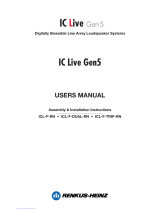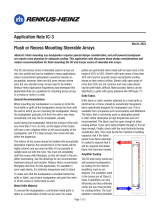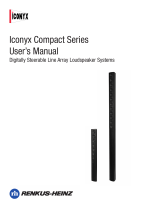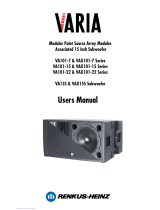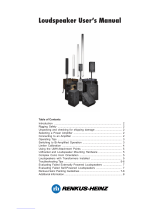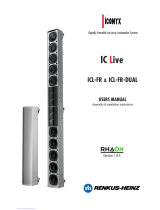Page is loading ...

IMPORTANT SAFETY INSTRUCTIONS
1. Read these instructions.
2. Keep these instructions.
3. Heed all warnings.
4. Follow all instructions
5. Do not use this apparatus near water. The apparatus shall
not be exposed to dripping or splashing and no objects lled with
liquids, such as vases, shall be placed on it.
6. Clean only with dry cloth.
7. Do not block any ventilation openings. Install in accordance with
the manufacturer’s instructions.
8. Do not install near any heat sources such as radiators, heat
registers, stoves, or other apparatus (including ampliers) that
produce heat.
9. Do not defeat the safety purpose of the polarized or grounding-
type plug. A polarized plug has two blades with one wider than the
other. A grounding type plug has two blades and a third grounding
prong. The wide blade or the third prong is provided for your safety.
If the provided plug does not t into your outlet, consult an electri-
cian for replacement of the obsolete outlet.
10. Protect the power cord from being walked on or pinched
particularly at plugs, convenience receptacles, and the point where
they exit from the apparatus.
11. Make sure the power cord remains readily accessible at all
times.
12. The AC Power Cord is the AC Mains disconnect.
13. Only use attachments/accessories specied by the manufac-
turer.
14. Disconnect this apparatus during lightning storms or when
unused for long periods of time.
15. Refer all servicing to qualied service personnel. Servicing is
required when the apparatus has been damaged in any way, such
as power-supply cord or plug is damaged, liquid has been spilled
or objects have fallen into the apparatus, the apparatus has been
exposed to rain or moisture, does not operate normally, or has been
dropped.
“WARNING - TO REDUCE THE RISK OF FIRE OR ELECTRIC
SHOCK, DO NOT EXPOSE THIS APPARATUS TO RAIN OR
MOISTURE”
“CAUTION: THESE SERVICING INSTRUCTIONS ARE FOR USE
BY QUALIFIED SERVICE PERSONNEL ONLY. TO REDUCE THE
RISK OF ELECTRIC SHOCK DO NOT PERFORM ANY SERVIC-
ING OTHER THAN THAT CONTAINED IN THE OPERATING
INSTRUCTIONS UNLESS YOU ARE QUALIFIED TO DO SO”.
CAUTION
To reiterate the above warnings: servicing instructions are for
use by qualified personnel only. To avoid electric shock, do
not perform any servicing other than that contained in the Ope-
ration Instructions unless you are qualified to do so. Refer all
servicing to qualified personnel.
Eindrigliche Warnung: Wartungsvorschriften dienen nur der
Benutzung durch qualifizieres Personal. Zur Vermeidung eines
elektrischen Schlages keine anderen als die in den Betriebsvor-
schriften beschriebenen Wartungsarbeiten ausführen, es sei denn
Sie sind dafür qualifiziert. Wartungsarbeiten auszuführen.
The lightning flash with arrowhead symbol,
within an equilateral triangle, is intended to
alert the use to the presence of uninsulated
"Dangerous Voltage" within the product's en-
closure that may be of sufficient magnitude
to constitute a risk of electric shock to hu-
mans.
The exclamanation point, within an equilateral
presence of important operating and mainte-
nance (servicing) instructions in the literature
accompanying the product.
VORSICHT
RISK OF ELECTRONIC SHOCK:
OPEN ONLY IF QUALIFIED AS
SERVICE PERSONNEL
GEFAHR EINES ELEKTRISCHEN SCHLAGES:
NUR VON QUALIFIZIEREM WARTUNGSPERSONAL
ZU ÖFFNEN
Der Blitz mit nach untenzielendem Pfeil in
einem gleichseitigen Dreieck weist den
Benutzer auf das Vorhandensein einer
unisolierten, "gefährlichen Spannung" im
Gehäuse hin, die stark genug sein kann, einer
Person einen gefährlichen elektrischen Schlag
zu versetzen.
Das Ausrufezeichen in einem gleichseitigen
Dreieck weist den Benutzer auf wichtige
Betriebs- und Wartungsvorschriften in den
beiliegenden Unterlagen des Gerätes hin.
Erklärung der graphischen SymboleExplanation of Graphical Symbols
IMPORTANT
Your Iconyx Steerable Column Loudspeaker contains no user-serviceable
parts and all service should be referred to qualied service personnel.
Users Manual ICL-FR
2

TABLE OF CONTENTS Page
Introduction 4
Technical Support 4
Assembly Instructions 4
Address Number Verication 6
Introduction To RHAON 7
RHAON Organization 8
Preparation
Computer Requirements 10
Software Installation 10
Customizing Your RHAON Workspace 11
Virtual System Design 12
Assigning a Static IP Address 13
Saving Your Work 14
Network Manager 15
Connect Mode
Linking Software With Networked Loudspeakers 16
Properties Windows 18
Assigning Digital & Analog Inputs 20
CobraNet Signal Routing 21
Beam Steering 23
Presets 31
IC-RC1 Remote Preset Control 33
Control Mode 34
User Congurable DSP Functions 35
Saving Changes 36
Saving To Presets 36
All Loudspeakers & Group Control 37
Copy Settings / Copy Presets 39
Reset 39
Supervise Mode 40
Event Logging & Notication 42
General Preferences 43
Password Protection 44
Installation & Servicing
Wall Mounting 46
Suspended (Flying) 47
Servicing 47
Appendix I
Audio Evacuation & Life Safety Functions 48
Appendix II:
RHAON System Block Diagrams 49
IC-ICR Remote Control 52
Appendix III:
ICL-FR Hardware Inputs, Outputs & Indicators 53
Appendix IV:
Keeping Your RHAON Program Up-To-Date 54
Software Updates 55
Updating Microcontroller Firmware 56
Updating DSP Firmware 58
Appendix V:
Using Third Party Controllers 60
Servicing and Troubleshooting 62
RHAON Network Trouble Shooting Tips 63
Network Manager 65
ICL-FR Dimensions & Technical Specications 73
Index 75
3
Users Manual ICL-FR

INTRODUCTION
Congratulations on your purchase of a Renkus-Heinz RHAON empowered digitally steered
Iconyx IC Live column loudspeaker. We hope you enjoy it.
Your Iconyx IC Live steerable column loudspeaker was carefully tested and inspected before
leaving our factory and should have arrived in perfect condition. Please carefully inspect the
shipping carton(s) and loudspeaker(s) for any noticeable damage, and if any damage is found,
immediately notify the shipping company. Only you, the consignee, may institute a claim with
the carrier for any damage incurred during shipping. Be sure to save the carton(s) and all pack-
ing material for the carrier’s inspection. It is also a good idea to save the carton and packing
material even though the loudspeaker arrived in good condition. If you should ever need to ship
the loudspeaker, it should be shipped in its original factory packaging.
TECHNICAL SUPPORT
If you have any questions about RHAON-Empowered Loudspeakers or encounter a problem
designing, installing, setting up or operating a RHAON system, please call our technical sup-
port staff at 949-588-9997 and ask the operator for technical support on RHAON. Call Monday
through Friday from 8:00 AM to 5:00 PM Pacic Time.
The latest information on RHAON Technical Support is always available online at http://www.
renkus-heinz.com/support/software-support/rhaon/e-mail.html. You will also nd a support
request form at http://www.renkus-heinz.com/support/request-info/tech-info/index.html.
ASSEMBLY INSTRUCTIONS
To simplify shipping and handling, ICL-FR-DUAL and ICL-FR-TRIP arrays are shipped as
modules in separate cartons and need to be assembled in the eld. All the hardware needed to
assemble the ICL-FR-DUAL or ICL-FR-TRIP is included in the cartons.
If you ordered a HK-ICL series mounting hinge kit with your ICL-FR array, the hinge hardware
will be packed with the other hardware.
In the following instructions, the term “module” is used to refer to one of the 8-channel sections
of the nished assembly, which is called a column or a column array.
Prepare an assembly area. Each module is 4 feet long, so you need a at surface at least 8 feet
long to assemble the dual array; 12 feet for the triple array. We suggest covering the assembly
area with a heavy cloth or some other soft material to prevent damaging the nish on the cabi-
nets while assembling them.
Place the modules in their respective positions on the assembly area. Avoid resting the modules
on their grille. The modules are heavy and may deform the grille. Instead, rest the modules on
their sides or back.
Note: The proper way of assembling the modules is shown in the photo to the right. Note
that the horn sections of the two ICL-FR modules are joined together as shown in the
photo. Proper orientation of the ICL-LM-FR module in “Triple” arrays is also important.
Make sure the LM module’s input (amplier) port is at the top of the array. Refer to page
73 for details.
Users Manual ICL-FR
4

If ypu also purchased a mounting hinge kit for th column array
Attach the heavy joining plate from its hardware package to the
rear of the cabinet using the machine screws provided with the
hardware. See below. Tighten the screws loosely to allow a little
movement while joining the two modules.
Then plug one end of the at wire signal cable into the socket
provided. It only goes into the socket one way and the cable is
reversible. It does not matter which end goes into which module.
Using a #1 Phillips screw driver, scarefully ecure the connector
with two 4-40 Phillips head screws (supplied). Make sure the
connector is fully seated.
5
Users Manual ICL-FR
If you purchased several ICL-FR and ICL-FR-LM arrays separate-
ly and now want to turn them into a dual or triple array, you will
also need one or two ICL-F-KIT-UP joining kits. Each kit includes
two heavy metal joining plates and a short at wire signal cable
with connectors on each end.
The rst assembly step is to remove the top of both ICL-FR mod-
ules. To remove the top, remove the eight machine screws from
each side of the cabinet and lift the end piece and its mounting
brackets out of the cabinet as shown.
The next step is to install the two heavy joining plates They will
be packed with the hardware, if you ordered them as part of an
ICL-FR-DUAL or ICL-FR-TRIP..
Note: The graphics that follow show the two joining plates
mounted in one cabinet. In actual practice, it is better to mount
one plate in one cabinet and the other in the second cabinet. They
should be attached to the side where the small db15 signal cable
connector is located. This reduces the possibility of damaging the
connector while sliding the two cabinets together.
Use the mounting bracket machine screws you removed to install
the two heavy joining plates .Tighten the screws lightly. The
joining plates need to be a little loose to slide easily into the other
cabinet.

Align the two modules to be joined so that the top of the lower one and the bottom of the upper one are close to one
another, say 4” (10 cm) apart.
Insert the free end of the short ribbon cable into the socket on the second module. Using a small Phillips screw driver,
secure the connector with two 4-40 Phillips head screws (supplied). Make sure the connectors are fully seated. If neces-
sary, use a ashlight to check because if the connectors are not seated properly, you may have to disassemble the column
in order to seat them correctly.
Align the two modules and slide them together, making sure the holes in the heavy joining plates align with the holes in the
modules. Install the remaining screws into the joining plates and tighten all the screws. The assembly is now complete.
If you are making a triple array, repeat the procedure to join the ICL-FR-LM module to the other two modules.
Address Number Verication
All that remains is to verify that the Master and Slave modules are properly identied. This is accomplished with the Mas-
ter/Slave dip switches located on the input panels. See page 55 for a detailed view of an input panel. The settings were set
at the factory, but it’s always a good idea to check the settings.
Normally the bottom module will be the Master and the other modules will be the Slaves numbered 1 & 2 in ascending
order. However, as long as the switches are set properly any module can be designated as the Master. You may, for
example, designate the top module as the Master to allow you to bring the signal cables into the top of the array. Set the
switches in accordance with the drawing shown below. On single ICL-FR arrays the dip switches should always be set to the Master setting
(“00”).
Be aware that certain functions will be disabled on the Slave modules as their control has been turned over to the Master module. Preset Up,
Preset Down, Preset Enter , Input Pad, Volume Up & Volume Down, AES/EBU Input and Mute functions are all controlled only by the controls
on the Master module. Signal cables must be brought into the Master module. AC power is brought into each module.
Note that if you connected power to the Array before setting the dip switches, you will need to disconnect it and reconnect it before the dip
switch settings will take effect.
Users Manual ICL-FR
6
MASTER
SLAVE
MASTER
SLAVE
MASTER
SLAVE
Setting
for
Master
Setting
for
Slave #1
Setting
for
Slave #2

7
Users Manual ICL-FR
INTRODUCTION TO RHAON
Your digitally controlled, steerable Iconyx IC Live ICL-FR column loudspeaker is RHAON Empowered.
RHAON (“rayon”), the Renkus-Heinz Audio Operations Network, is the rst practical system to combine digital audio distribution with
precise control and supervision of self-powered loudspeakers. RHAON uses standard Ethernet hardware, advanced CobraNet technology
and on-board DSP (digital signal processing) to turn self-powered Renkus-Heinz loudspeakers from “black boxes” into “smart boxes” that
can respond to user input in real time.
General Information
Your RHAON-Empowered Loudspeaker’s amplier stores all onboard DSP settings, including the input source selection, in non-volatile
memory. Analog Input 1 has been pre-selected at the factory so you can use the loudspeaker as an ordinary self-powered loudspeaker.
Just connect a line level audio signal to Analog Input 1, connect the AC power and turn the loudspeaker on. This input is always available
for testing the loudspeaker and amplier, regardless of the programmed input settings.
You will need a computer with a NIC (Network Interface Card) and Windows-based RHAON software to change the input selection or any
of the other DSP settings. Once your DSP settings are stored in non-volatile memory, the computer can be disconnected from the network.
You will need to connect a computer only when you want to change the settings or when you want to use the supervise feature.
Renkus-Heinz engineering has programmed the onboard DSP to optimize the loudspeaker’s performance and to ensure its safe operation.
Replace the RHAON hardware module only with another unit that has been factory programmed for the same loudspeaker. Contact our
Technical Support Department for details and assistance.
Access Control Note
RHAON systems feature several levels of password-protected access control to prevent inadvertent or unauthorized changes of the control
settings. Even when you connect a computer running RHAON software, you may be denied access to some or all of the Connect and
Control mode functions, depending on how the access control system is congured. For further information on password protection refer to
page 44 of this manual or contact the person responsible for the setup and tuning or commissioning of your system.
Important
If you will be controlling/supervising your RHAON empowered system with a laptop, do not close the laptop’s lid or allow your
laptop to go to sleep (hibernate) during operation. Some CobraNet components may not wake up from hibernation when your
computer awakens. Your system will continue to operate normally until you attempt to change any of the settings. For ex-
ample, until you attempt to change your Presets (they won’t load) or change your EQ settings and you can’t save them to the
loudspeaker(s). Communications between your computer and the loudspeakers on the network have been disrupted by the
malfunctioning CobraNet components. To prevent this set your laptop’s Hibernation / Sleep settings to “Never”.
Note that this does not affect normal operation. Your system will continue to operate normally until you try to change some of
the settings. If this occurs or some other WindowsTM event causes the CobraNet components to malfunction, you will need to
either Restart your computer or use the Windows Task Manager to return to normal operation. To use the Task Manager, close
RHAON (and, if running, CobraNet Discovery) and use “Ctrl-Alt-Delete” to open the Task Manager. Select the “Processes” tab
and look for ‘PACNDISCO.EXE’ and ‘PASSBRIDGE.EXE’ (Windows may shorten the names and add ‘~1’). Select them and click
“End Process”. Then re-open RHAON.

RHAON ORGANIZATION: Three Fundamental Audio Operations
Before we go on, let’s take a look at the structure of RHAON. Audio operations comprise three fundamental areas that are necessary for
the success of any sound system:
CONNECT
In a RHAON system there are both physical connections and network (software) connections. The physical connections are made using
UTP cable meeting at least CAT5 standards and/or analog cables as well as AC power cords. Network connections are established in
the software. You don’t have to make the two types of connections in a particular order. RHAON software allows you to set up a “virtual
system” using beam steering, pre-congure DSP settings for individual loudspeakers and establish and store preset congurations before
the physical connections are made. If you are using RHAON’s CobraNet digital audio functions, you will also need to connect a CobraNet
source (an analog to CobraNet converter) to the network.
CONTROL
You can control many DSP parameters in real time, and/or pre-congure them in software prior to installation and make nal adjustments
during commissioning or setup. Preset congurations are available for instant recall.
SUPERVISE
RHAON allows both real-time supervision while the system is in use, and remote supervision with fault logging and operator alerts via e-
mail, text messaging, etc. Every single driver an array is supervised and its status displayed, and any failures detected trigger an alarm.
At any time you can switch into any of the three RHAON operating modes using the Connect | Control | Supervise tool bar directly above
the work space. You can also switch between the three fundamental operating modes and the Beams / Presets folder using tabs inside the
Loudspeaker Properties windows.
Users Manual IC-R
8

9
Users Manual ICL-FR
TYPICAL PROJECT WORKFLOW
PREPARATION
INSTALL RHAON
software under
Windows XP, Vista,
Windows 7
SET COMPUTERS
Static IP
Address
CHOOSE BACKGROUND IMAGE
This can make it easier to see
where Groups and Loudspeakers
are in the venue
ADD VIRTUAL SPEAKERS
or scan network for actual
loudspeakers
GROUP VIRTUAL SPEAKERS
or actual loudspeakers
found on your network
OPEN NETWORK MANAGER
To verify integrity of the Ethernet
network
CONNECT
SCAN THE NETWORK
RHAON assigns
IP Addresses as needed
ASSOCIATE VIRTUAL &
ACTUAL LOUDSPEAKERS
Drag from left panel,
drop on icon in right panel
SELECT DIGITAL and/or
ANALOG INPUTS
ROUTE COBRANET
CobraNet Source
Drag-and-Drop Tx/Rx links
BEAM STEERING
Configure and Aim
Array’s Sonic Beams
PRESETS
Control & Store Presets
CONTROL
CONTROL PANEL
Configure Loudspeaker
Array
EQUALIZATION
8-band parametric EQ,
hi-and lo-shelving
hi-pass and lo-pass
COMPRESSION
Threshold / Ratio
Attack / Release
Soft Knee / Trigger Point
DELAY
0 to 340 milliseconds @ 48 kHz
0 to 170 milliseconds @ 96 kHz
PRIORITY OVERRIDE
Attack / Release
Threshold / Hold
Engage / Disengage
SUPERVISE
OPERATOR ALERTS
RHAON indicates problems
such as over temperature,
clipping or driver failure at Sys-
tem, Group and Loudspeaker
levels
DETAILED INFORMATION
Just click through to the
loudspeaker’s Supervise screen
to identify the nature of the
problem and take corrective
action
FAULT LOGGING
RHAON logs the fault
conditions you specify to a
file on your hard drive
OPERATOR NOTIFICATION
via e-mail or text message
(if your computer has a second
NIC with an Internet
connection)
MULTI-LEVEL PASSWORD
PROTECTION
restrict access to Connect and
Control functions

Software Installation
You need a Windows PC running RHAON software in order to maximize the performance of RHAON-Empowered loudspeakers and your
RHAON system. You can use RHAON software during the design stage, for system setup, tuning and commissioning, and for remote con-
trol and supervision. You can disconnect the computer from the network after commissioning the system, if you or your client are not using
RHAON’s system supervision capabilities.
RHAON software will run on any PC computer that meets or exceeds the following requirements.
Processor / Speed: Pentium / 800 MHz minimum (faster recommended, especially for large systems)
RAM: 256 MB minimum (more recommended, especially for large systems)
Interface: At least one Network Interface Card (NIC) with a 100 BaseT (100 MB/second) or faster
Ethernet Port; two NICs are needed if the computer will also be used to e-mail alerts
Operating System: Windows XP, Vista and Windows 7 with either 32-bit or 64-bit processors
Associated Software: .NET Framework 3.5 or higher (supplied with RHAON installation CD)
Screen Resolution: 1024 x 768 or higher
To install the software insert the RHAON installation disk into the computer’s CD drive. The installation program should start automatically.
During the installation you will need to select either the 32-bit or the 64-bit install RHAON 1.8.0 is downwards compatible with earlier
versions of RHAON Microcontroller and DSP rmware so you do not need to uninstall a previous version of RHAON before
installing program version 1.8.0. However, new program features may not function in loudspeakers running earlier versions of
rmware.
If the installation program doesn’t, start automatically, go to your Start menu. Then select Settings/Control Panel & Add/Remove Programs.
Click on Install to start the installation manually.
Click on Next to proceed to the next step. Then follow the screen prompts until the installation is complete.
The installation program will install RHAON into a Renkus-Heinz/Rhaon folder on your hard drive. It will not uninstall earlier versions of
RHAON. If you want to delete an earlier version, use Settings/Control Panel and Add/Remove to remove it.
The RHAON Installer will put a RHAON Icon on your desktop. Double click on it to open RHAON. You should see the opening screen
shown at the top of the next page.
Users Manual ICL-FR
10
PREPARATION

Users Manual ICL-FR
11
PREPARATION
Notice that the program warns you if your display settings may cause viewing problems. If you are using “Large Fonts,” we recommend
you change to the default 96 DPI setting to avoid possible viewing problems.
The program also includes a number of pop-up messages that
alert you to new RHAON features and help guide you though the
creation of a successful project. Typically, most of these pop-up notes can be turned off once you become familiar with the program and no
longer need their assistance..
Customizing Your RHAON Workspac
The grey background with RHAON watermark can easily be changed to something more useful, such as a block diagram of your system
or a photo of the venue. To change the background, go to the Options pull-down menu and select Background Image/Load Image. Then
browse to the drawing or photo you want to use.

Users Manual ICL-FR
12
PREPARATION
Virtual System Design
RHAON software can save you time at the job site by enabling you to set up a complete virtual loudspeaker system before you go to the
site. When you get to the site, you connect your computer to the network, link the virtual loudspeakers with their real counterparts, and
upload the settings to each individual loudspeaker.
Your loudspeaker system can include individual loudspeakers, groups of multiple loudspeakers, or a combination of both. Groups as well
as individual loudspeakers can be controlled (turned On or Off, Muted, have their levels adjusted, and more) using your mouse.
We recommend you consider using “Groups” in your designs. You can always control each individual loudspeaker, but quite often it’s more
efcient to have them grouped together.
You begin designing a virtual system in the
main RHAON window, which is divided into
two sections. The left vertical panel lists
all the available devices in a directory tree
format. The larger section on the right displays
loudspeaker icons and other specialized work
areas: the All Loudspeakers icon represents
your loudspeaker system. It functions as a
“group” control for all the loudspeakers. If you
need more space on the right, minimize the
left hand section by clicking on the Close icon
on its right edge.
Let’s say we want to add two ICL-FR
loudspeakers to our system. Clicking on Add
Virtual Device(s) in the top left tool bar opens
an Add New Speakers window. Browse to
nd the loudspeaker model you want to add
(ICL-FR in the example) and select it. Type a
quantity (2 in our screen shot) into the Amount
To Add eld and click the Add button.
In the screen shot to the right, icons repre-
senting the two ICL-FR arrays have been
added to the workspace and moved to their
approximate location by grabbing them with
the Mouse Cursor and moving them.
Now you can dene initial DSP settings for
your virtual loudspeakers. The DSP settings
can then be uploaded to the actual loudspeak-
ers once your computer has been connected
to the loudspeaker network at the site.

Users Manual ICL-FR
13
PREPARATION
Assigning a Static IP Address to the RHAON Host Computer
You can begin your preparation ofine in a virtual environment,
but to make a RHAON system operational you have to connect
your computer and RHAON-Empowered loudspeakers to an
Ethernet network.
You need to associate the virtual loudspeakers you have created
in RHAON with the actual loudspeakers installed in the system.
The rst step is to make sure the computer’s Network Interface
Card (NIC) is properly setup .
Your NIC must have a static IP address assigned to it: this
enables RHAON software to communicate to all the loudspeakers
on the network.
Each device on the RHAON/CobraNet network must have a
unique IP address in order to communicate. RHAON software
can assign the IP addresses to your networked loudspeakers
automatically.
In Windows XP, go to My Computer/Control Panel/Network Con-
nections. If you are using Vista or Windows 7, go to Start/Control
Panel/All Control Panel Items/Network and Sharing Center.
Find the connection you wish to use. It will likely be called “Local
Area Connection”, unless you have renamed it. Also, note the
model number of the NIC, as the RHAON software will require it
later. Right click the icon and click “Properties” to open its Proper-
ties window.
Then, double click on Internet Protocol (TCP/IP) to open its
Properties window. You will probably see that your computer
is congured to Obtain an IP Address Automatically. Change
this to Use the Following IP Address and enter an IP address
of, for example 192.168.1.1. Next, insert 255.255.255.0 into the
Subnet Mask eld. Click OK and you are ready to connect to the
RHAON/CobraNet network.
Note: IP addresses are in the format xxx.xxx.xxx.xxx where
“xxx” is any digit from 0 - 255. Local IP addresses that ap-
pear only to other devices on a LAN (Local Area Network) are
dened as ranges 192.168.xxx.xxx, 172.16.xxx.xxx to 172.31.
xxx.xxx and 10.xxx.xxx .xxx.
192-168.xxx.xxx is the range most commonly used and we
suggest you use it unless you have a good reason to use
another range.

Users Manual ICL-FR
14
PREPARATION
Before connecting the network’s RJ-45 con-
nector into your computer’s Ethernet port, you
need to make sure that RHAON has the correct
network settings. In the RHAON software, go to
the Options menu and select “Preferences”. On
the General tab, make sure the correct NIC is
selected in the Adapter eld. The available selec-
tions are based on the listing of your network
connection you noted earlier. Refer to page 13.
Each device on the RHAON / CobraNet net-
work must have a unique IP address in order to
communicate over the Ethernet network. The
RHAON software can assign IP addresses to all
the RHAON-Empowered loudspeakers connected
to your network.
Before RHAON can scan your network and
assign IP addresses to the devices it nds, you
need to specify a range of IP addresses to use.
The static address assigned to the computer in
Windows establishes the “subnet” you will be
using. A subnet is the rst three parts (“octets”)
of the IP address. In the example, the subnet is
192.168.1. Therefore, all the IP addresses on the
network will be in the form 192.168.1.xxx.
Type two valid IP addresses into the two elds: one for the lower limit of the range and the other for the upper limit. Since 192.168.1.1
is already in use by the RHAON host computer, the lower limit must be at least 192.168.1.2. The upper limit can be set as high as
192.168.1.255, but needs to be only high enough to accommodate all the devices on the network. Remember each device must have its
own IP number.
Click OK and connect the computer to the RHAON/CobraNet Ethernet network, i.e., plug in the CAT5 cable.
Note that you do not have to create virtual loudspeakers before connecting your computer to the network. RHAON software can
scan the local Ethernet network, identify all connected loudspeakers, assign IP addresses to them, and list them in the work-
space directory tree. Creating a virtual system before connecting to the network is an option that can in many cases save you
time at the job site.
Saving Your Project
It’s always a good idea to save your work regularly when using any computer software. If you have not done so, RHAON will remind you
with a prompt if you attempt to close the program without saving.
When you are ready to save your work, selecting Save from the File pull down menu will open the familiar Windows File Save screen.
Name your project, browse to the desired le location and Save the le.
Note that you are saving the project le to your computer and not saving (loading) it into the loudspeakers.

Users Manual ICL-FR
15
PREPARATION
Saving Changes
Each loudspeaker’s Connect, Control and Supervise Properties window also has a Save button. Pressing the Save button will save the
change(s) to the project le and to the associated loudspeaker’s ash memory.. Note that although the changes are being sent to the
project le, the project le itself is not being saved.
The Network Manager
Most Iconyx IC Live ICL-FR setup and installation problems are “network problems” and not Iconyx or RHAON problems. Your Iconyx array
was factory tested before it left our factory and barring shipping damage should be in perfect operating condition. The RHAON Network
Manager allows you to check the integrity of the Ethernet network before you actually link to the loudspeakers. It is accessed from the File
pull down menu and identies network problems for you before you waste a lot of time checking out the loudspeaker.
In the example shown here the ICL-FR Left obviously has a network communications problem while the CF61 DBL and the VoiceBox are
suspect.
For more details on the Network Manager refer to page 65.

Linking Software Icons with Networked Loudspeakers
To connect a RHAON network, you rst make all the hardware connections, and then (if you are using CobraNet for digital audio distribu-
tion) assign signal routing using RHAON software. A typical amplier input panel is shown on page 53 in Appendix 1.
Let’s say you’ve connected all your Ethernet inputs and outputs. Every venue is different: so is every network. For examples of RHAON /
CobraNet networks, see Appendix II.
Remember: before connecting your computer running RHAON software to the network, you should have assigned it a static IP address.
If you’ve done that, connect the computer to your RHAON network and click on the Scan Network icon. RHAON software will nd all
networked loudspeakers and any other CobraNet devices on the network and automatically assign them IP addresses if they don’t already
have one.
RHAON will then list them under Network in the directory tree. Note that you did not have to rst create virtual loudspeakers. RHAON
found the actual loudspeakers.
If RHAON can’t nd any CobraNet devices on the
network, the prompt shown to the right will appear
to let you know that something is wrong and to offer
trouble shooting hints. For more detailed trouble
shooting instructions please refer to page 65.
The next step is to drag each loudspeaker’s directory
listing into the work space. This will create an icon for
it. If you created virtual loudspeakers before scan-
ning the network, drag each individual listing from the
Network folder into the main work space and drop it
on the appropriate icon.
When you link a networked loudspeaker with a soft-
ware icon, RHAON interrogates the loudspeaker to
make sure the DSP settings stored on your computer
are synchronized with those in the loudspeaker’s
onboard memory. If they are not, RHAON displays a
prompt that allows you to choose which settings to
use.
To upload settings from your computer to the
loudspeaker, click on Overwrite Settings on DSP. To
download settings from the loudspeaker and copy
them into computer memory, click on Read Settings
from the DSP.
If you were linking an existing project on your com-
puter into an existing network, the dialog box shown
to the right will appear and you will need to decide
which settings you want to use, the ones stored in
your project le or the ones present in the loudspeak-
ers.
Users Manual ICL-FR
16
CONNECT

Continue until all networked loudspeakers are
linked to icons in the main workspace. When an
icon is linked to a networked loudspeaker, the
status indicator under its name changes from
Unassigned (Red) to OK (Green). Notice that
the directory listing for that loudspeaker also
moves from the Network folder to the Speaker
folder.
To conrm that the setup is complete, return
to System Layout and place the cursor over
the loudspeaker listings in the directory tree.
As you can see from the pop up
screens, RHAON has assigned
IP numbers to each of the loud-
speakers.
Note that you could also open the
Network Manager and view this same informa-
tion in list form. To open the Network Manager,
go to the File pull down menu and select Network Manager.
Let’s take a closer look at the Connect Mode loudspeaker icon.
Clockwise from the top, the rst item is the icon’s name. The loudspeaker symbol on the right of the Status Bar is a Mute control: click on it
to mute or un-mute the loudspeaker. The green triangles on the far right represent CobraNet Transmitters (Tx). Each CobraNet Transmitter
can transmit one channel of information from the DSP out to the CobraNet network. The green Status bar reading OK at the bottom of the
icon indicates this icon has been linked to a networked loudspeaker and is operating satisfactorily. A red bar would indicate a problem and
the text would identify the problem, such as unassigned.
To its left of the status bar is a “W” button. Click on it to Wink the light on the front of the networked loudspeaker that is linked to the icon.
This makes it easy to identify the loudspeaker and conrm its location. On the outside left edge of the icon are two red triangles represent-
ing CobraNet Receivers (Rx): each can receive one signal out of a bundle of up to 8 audio channels from the network.
Double clicking on any loudspeaker’s Connect icon opens the Connect Properties screen associated with the linked loudspeaker. More
details on Properties screens are on the next page.
Users Manual ICL-FR
17
CONNECT
CobraNet Receivers
Turns “Wink” Light ON & OFF Status Indicator
Name CobraNet Transmitters
Turns Mute ON & OFF

Users Manual ICL-FR
18
CONNECT
Properties Windows
The three operational modes of RHAON, Connect, Control and Supervise all have their own unique Properties window (see below). Notice
that the vertical pane on the left side of each window is identical.
The Connect, Control and Supervise tabs at the top of the window allow you to switch between the three operating modes without return-
ing to the main window. You can also open Properties les
for more than one loudspeaker at the same time and move
them around the work space.
The Connect Properties window gives you the ability to:
1. Select and connect the multiple inputs of Rhaon empowered
loudspeakers to the amplier(s)
2. Select and send input signals to the CobraNet network
3. Select one of the CobraNet digital audio channels, if Co-
braNet’s multi channel digital audio capability is being used.
The Control Properties window provides setup and control fa-
cilities for the loudspeaker’s on board DSP. It includes controls
for the:
1. Compressor
2. 8-band parametric equalizer, hi & lo band roll off and shelv-
ing lters
3. Signal delay
4. Priority override controls.
The Supervise Properties window allows you to:
1. Monitor and test the status of each transducer’s driver
2. Check the status of the voltage detect circuit, the fault relay
and the Ethernet network.
Notice that each one of the array’s transducers is being
supervised.

Users Manual ICL-FR
19
CONNECT
The vertical pane in each Properties window provides for loudspeaker identication and selected control features. See below for details.
Status Indicators: The Thermal, Peak and Fail indicators above the output meter provide critical information on the array’s status. The
Peak indicator will ash yellow or red whenever the device’s peak limiter is triggered. It’s normal for the indicator to ash occasionally if
the loudspeaker is being used close to its rated output. Flashing frequently is a sign that the system volume needs to be turned down. The
Thermal indicator will start to ash yellow as the amplier temperature approaches a preset level and will turn red if the temperature contin-
ues to increase as a warning the amplier is about to be shut down. The Fail indicator glows red when the amplier has been shut down by
the protective circuitry. Heat related shutdowns will reset automatically after the amplier cools down to a safe temperature.
As a further protective measure, the amplier’s gain will gradually be reduced in response to overheating and/or to high an input level.
However, it’s best to manually reduce the input signal level (overall system volume) in response to distress signals.
Power On/Standby Button: Note that the Power On/Standby button will not show while operating in the virtual mode. It appears only
when associated with an actual array.
Loudspeakers model number or name
Input signal level bar graph; “0” indicates
the onset of input clipping. Analog inputs
clip at +12 dBu without the 10 dB input
pad, +24 dBu with the pad.
Volume control slider; adjust by grabbing
slider with mouse or by using up/down
arrows. Settings adjustable from “0” to -50
in 1 dB steps, then to -100 dB in one step;
settings below -8 dB prevent the loud-
speaker from reaching full output.
Inv. button inverts the input signal polarity;
glows green when signal is inverted. Use
with caution.
Amplier temperature indicator and
bar graph.
Save button
Reads Save whenever a change is
made as a reminder of the need to save
changes.
Text elds for entering a name for the
loudspeaker and listing its location.
Press Wink with Light button to turn the
loudspeaker’s wink light on and off to aid in
identifying the loudspeaker and its location.
Press Wink with Audio to send a Tone
signal or Pink Noise to the loudspeaker.
Output status indicators for each amplier.
See Status Indicators below for details.
Output bar graph. “0” represents the
maximum uncompressed output level;
positive values indicate how far the signal
is overshooting into limiting; negative
values indicate the amount of headroom
left before the onset of limiting.
Mute button mutes the entire loudspeaker.
Press to restart the loudspeakers DSP in
the event of a malfunction.
Power On/Standby button. Turns ampli-
er On or places it in Standby. Turning
AC power to the Array On and Off is a
separate operation.
Loudspeakers DSP sample rate (48 kHz or
96 kHz). See page 21 for more details.

Users Manual ICL-FR
20
CONNECT
Assigning Digital and Analog Inputs
The larger right portion of the Properties windows vary with the operating mode. The Connect window is divided into an upper light grey
Internal DSP Connections section and and a darker grey lower CobraNet Routing Assignments section.
The Assign Amplier Inputs portion of the upper section is where you select which one of the Array’s multiple inputs will be routed to the
Main input and which one will be used for the Priority override circuit. RHAON Empowered loudspeakers have provisions for two CobraNet
digital audio inputs, two analog audio inputs and a serial audio (AES3 format) digital input. Selecting the input is as simple as clicking on
one of the radio buttons.
Notice that the Analog 1 input includes a 10 dB pad. In the On position it inserts a 10 dB pad into the Analog 1 input, allowing input signals
as high as +24 dBu. Without the pad, the analog inputs clip at +12 dBu.
The square Signal Present indicators turn green whenever a signal is present.. You can activate any of the analog and CobraNet digital
inputs in the upper group. If you select either of the AES/EBU inputs in the lower group, all Analog and CobraNet inputs are disabled.
The right hand Assign Cobranet Outputs portion of the upper section lets you use any of the audio inputs or amplier outputs as an output
to the CobraNet network, except for the AES/EBU inputs. AES/EBU signals are clocked separately from CobraNet and cannot be output to
CobraNet from RHAON.
The lower CobraNet Routing Assignments section is where you select which CobraNet input channel you want to use and set up the output
transmitter.
You can use RHAON without digital audio distribution via CobraNet to Control and Supervise your system, or you can combine digital and
analog signal distribution for redundant signal path and/or life safety applications. However, if you use AES/EBU serial digital inputs,
all other audio inputs are automatically disabled.
If you are not using CobraNet for digital audio distribution in your RHAON system, you can skip the next few pages and move on to Beam
Steering (page 23).
/

